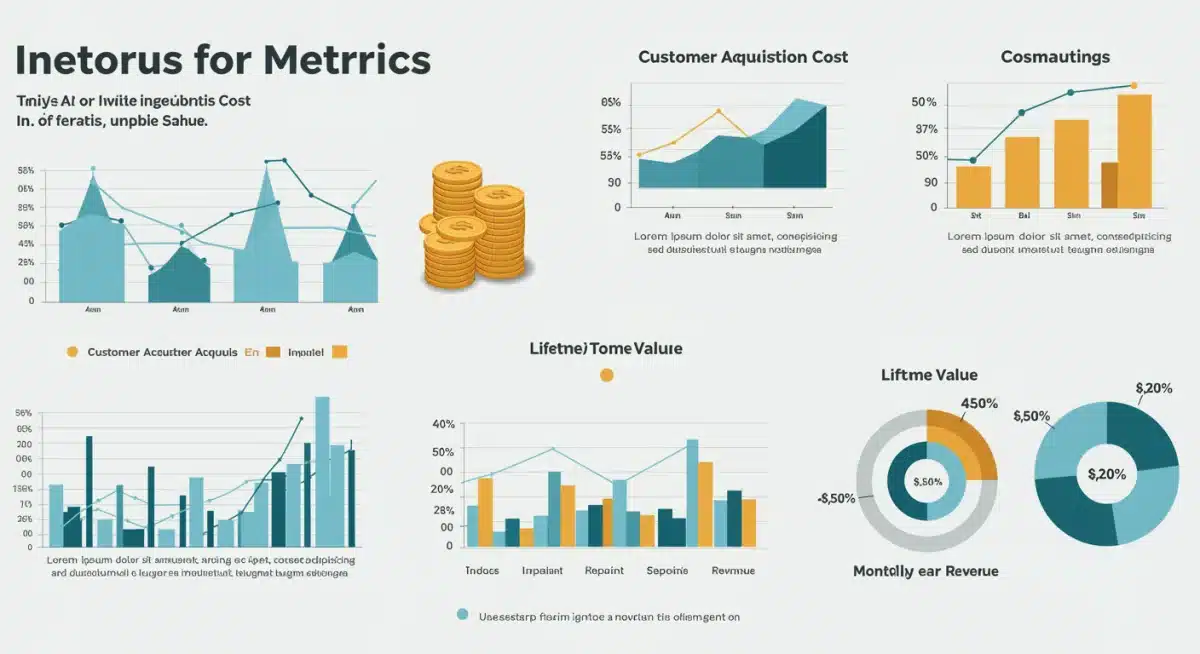Series A Funding: 3 Data-Driven Strategies for U.S. Startups in 2025

Securing Series A funding in the challenging 2025 U.S. market demands a robust, data-driven approach, emphasizing validated market fit, demonstrable traction, and a clear path to profitability to satisfy discerning investors.
Navigating the complex and increasingly tight venture capital landscape in 2025 presents unique challenges for U.S. startups seeking Series A funding. This environment demands more than just a great idea; it requires a strategic, data-driven approach to demonstrate viability, scalability, and a clear path to profitability. Understanding and implementing these strategies is crucial for securing the capital needed to propel your startup forward.
Understanding the 2025 Series A Landscape
The venture capital market in 2025, particularly for Series A funding, is characterized by increased scrutiny, a flight to quality, and a greater emphasis on sustainable growth over hyper-growth at all costs. Investors are operating with a more cautious mindset, demanding robust data and a clearer return on investment. This shift means that startups must present a compelling narrative backed by undeniable metrics, showcasing not just potential, but proven traction and a well-defined business model.
Previously, a strong vision and an experienced team might have been sufficient to attract early-stage investment. However, as capital becomes scarcer and risk aversion rises, the bar for Series A has significantly elevated. Startups are now expected to demonstrate product-market fit, a clear go-to-market strategy, and early revenue generation or substantial user engagement. The macro-economic climate, including interest rate fluctuations and geopolitical uncertainties, further contributes to this tightened market, making every pitch a critical opportunity to stand out.
The Investor’s Evolving Due Diligence
Investors are deepening their due diligence processes, moving beyond surface-level metrics to scrutinize the underlying unit economics, customer acquisition costs, and churn rates. They are looking for businesses that can achieve profitability without continuous reliance on external funding, reflecting a maturation in the venture capital industry.
- Increased Focus on Profitability: A clear path to positive cash flow is paramount.
- Unit Economics Scrutiny: Detailed analysis of cost per acquisition and customer lifetime value.
- Sustainable Growth Metrics: Emphasis on organic growth and efficient capital deployment.
- Resilience to Market Volatility: Demonstrating adaptability in uncertain economic conditions.
In essence, the 2025 Series A market demands a mature, well-thought-out business plan underpinned by verifiable data. Startups that can clearly articulate their value proposition, demonstrate strong early traction, and project a credible path to profitability will be best positioned to attract the necessary investment. This foundational understanding is the first step towards crafting a successful funding strategy.
Strategy 1: Hyper-Targeted Product-Market Fit Validation
In a tight funding market, generic claims of market need simply won’t suffice. The first crucial data-driven strategy for U.S. startups seeking Series A funding in 2025 is to provide irrefutable evidence of hyper-targeted product-market fit. This goes beyond anecdotal feedback; it requires a rigorous, quantitative demonstration that your product not only solves a real problem for a specific customer segment but also that this segment is large enough and accessible for scalable growth.
Achieving this level of validation involves deep dives into customer behavior, market segmentation, and competitive analysis. It’s about proving that your solution resonates deeply with a defined audience, leading to high engagement, low churn, and a clear willingness to pay. Without this foundational proof, even the most innovative technology will struggle to secure investor confidence in a cautious market.
Leveraging Data for Precision Targeting
To truly validate product-market fit, startups must employ a suite of data collection and analysis tools. This includes A/B testing, user behavior analytics, cohort analysis, and comprehensive surveys. The goal is to identify precise customer segments that exhibit the strongest affinity for your product and to understand the specific pain points your solution addresses for them. This granular understanding allows for a highly focused pitch to investors, demonstrating not just a market, but *your* market.
- User Engagement Metrics: Daily/monthly active users, session duration, feature adoption rates.
- Retention and Churn Rates: Demonstrating sticky product usage and customer loyalty.
- Customer Acquisition Cost (CAC): Understanding the efficiency of acquiring new users within the target segment.
- Customer Lifetime Value (CLTV): Projecting the long-term revenue potential from each customer.
The narrative to investors should not just state that you have product-market fit but illustrate it with compelling data. Showcase how your target customers are using your product, the value they derive, and how this translates into sustainable business growth. This level of detail provides investors with the confidence that their capital will be deployed into a validated and growing market segment.
Strategy 2: Demonstrating Scalable and Defensible Unit Economics
The second pillar of securing Series A funding in 2025 is the unequivocal demonstration of scalable and defensible unit economics. Investors are no longer content with top-line growth; they demand to see how each additional customer contributes to the bottom line, and how this profitability can be maintained or improved as the business scales. This involves a deep understanding of your costs, revenue streams, and the levers that drive profitability at a per-unit level.
In a tight market, capital efficiency is paramount. Startups must clearly articulate their path to profitability, showing how they can grow without burning through excessive amounts of cash. This requires meticulous financial modeling, a clear understanding of your cost structure, and a strategy for optimizing both customer acquisition and retention. A defensible business model, one that can withstand competitive pressures and market shifts, is equally critical.
Optimizing for Profitability and Efficiency
To present compelling unit economics, startups should focus on several key areas. First, a precise calculation of Customer Acquisition Cost (CAC) is essential, broken down by channel and segment. Second, a realistic and robust projection of Customer Lifetime Value (CLTV) is needed, supported by historical data and reasonable assumptions. The ratio of CLTV to CAC is a critical indicator for investors, signaling the efficiency and profitability of your growth engine.
- Detailed CAC Analysis: Pinpointing the most efficient acquisition channels.
- Robust CLTV Projections: Backed by data on retention, average revenue per user, and churn.
- Gross Margin Optimization: Strategies for improving the profitability of each unit sold or service delivered.
- Path to Contribution Margin: Showing how each new customer contributes positively after variable costs.

Furthermore, demonstrating defensibility involves showcasing competitive advantages that are difficult to replicate. This could include proprietary technology, strong network effects, unique data sets, or significant switching costs for customers. Investors want to see that your strong unit economics are not easily eroded by competitors. By meticulously presenting these financial aspects, startups can build a strong case for sustainable and profitable growth, which is highly attractive in a cautious funding environment.
Strategy 3: Cultivating Strategic Investor Relationships and Data-Backed Traction
The third critical strategy for securing Series A funding in 2025 is not just about having great data, but about effectively communicating that data within a network of strategic investor relationships. In a tight market, warm introductions and established trust can significantly differentiate a startup. This means actively engaging with potential investors long before a funding round, demonstrating consistent progress, and leveraging data to narrate a compelling story of traction and future potential.
Building relationships isn’t a passive activity; it involves strategic networking, attending industry events, and seeking mentorship from experienced VCs. When the time comes to pitch, these relationships provide a foundation of familiarity and credibility. Moreover, the pitch itself must be a masterclass in data storytelling, translating raw metrics into a clear, concise, and exciting vision for the future. Investors want to see that you understand your numbers inside out and can articulate their implications for growth and market leadership.
The Art of Data Storytelling in Investor Pitches
Your data-backed traction needs to be presented in a way that resonates with investor priorities. This means moving beyond spreadsheets and presenting a narrative that highlights key milestones, validates assumptions, and forecasts future success with justified confidence. Investors are looking for evidence of momentum, clear execution, and a team that can not only generate data but also interpret and act upon it effectively.
- Clear Milestone Achievement: Demonstrating progress against previously set goals.
- Growth Trajectory Visualization: Using charts and graphs to show upward trends in key metrics.
- Customer Testimonials and Case Studies: Qualitative data reinforcing quantitative success.
- Market Expansion Opportunities: Data-driven insights into future growth avenues and new segments.
The ability to connect your operational data to strategic outcomes is a powerful tool. Show how specific product improvements led to increased user engagement, or how targeted marketing campaigns resulted in a lower CAC. This level of detail not only proves your capabilities but also builds trust, positioning your startup as a data-savvy and execution-focused enterprise. In a competitive 2025 market, a strong network and a compelling data narrative are indispensable for attracting and securing Series A investment.
Building a Resilient Business Model for Long-Term Success
Beyond the immediate goal of securing Series A funding, U.S. startups in 2025 must also focus on building a resilient business model that can withstand future market fluctuations and competitive pressures. This forward-looking perspective is increasingly important to investors who are seeking long-term value creation. A resilient model is characterized by diversified revenue streams, operational efficiency, and a strong emphasis on customer loyalty, ensuring that the business can not only survive but thrive in evolving economic conditions.
This involves strategic planning that considers various scenarios, investing in robust infrastructure, and fostering a culture of continuous improvement and adaptation. Investors are looking for startups that are not just growing fast, but growing smart, with an eye towards sustainable profitability and market leadership. The ability to demonstrate this foresight and strategic depth will significantly enhance a startup’s appeal in a discerning funding environment.
Diversification and Operational Excellence
Diversifying revenue streams can provide a buffer against market downturns or shifts in customer preferences. This could involve offering complementary products or services, exploring new market segments, or adopting different pricing models. Operational excellence, meanwhile, focuses on optimizing internal processes to reduce costs, improve efficiency, and enhance the overall customer experience. This includes leveraging automation, streamlining workflows, and continuously monitoring key performance indicators.
- Revenue Stream Diversification: Exploring additional income channels beyond the core offering.
- Cost Structure Optimization: Identifying areas for efficiency gains without compromising quality.
- Customer Loyalty Programs: Strategies to boost retention and reduce churn through exceptional service.
- Scalable Infrastructure: Ensuring the technological and operational backbone can support rapid growth.

A resilient business model also implies a strong focus on intellectual property and proprietary advantages. This could be through patents, unique data sets, or deep industry expertise that creates significant barriers to entry for competitors. By combining these elements, startups can present a holistic picture of a business that is not only attractive for Series A investment but also poised for enduring success in the long run. This long-term vision is a powerful signal to investors seeking stable and impactful returns.
Navigating Investor Expectations and Due Diligence
Successfully securing Series A funding in 2025 hinges significantly on a startup’s ability to effectively navigate heightened investor expectations and rigorous due diligence processes. As the market tightens, investors are becoming more sophisticated in their evaluations, demanding not just compelling data but also transparency, responsiveness, and a deep understanding of market dynamics. Startups must be prepared to answer probing questions about their business model, financial projections, team capabilities, and competitive landscape with precision and confidence.
This means having all your ducks in a row well before engaging with potential investors. From detailed data rooms to comprehensive legal documentation, every aspect of your business will be scrutinized. Proactive preparation, anticipating investor concerns, and having well-articulated answers ready are crucial for building trust and demonstrating professionalism. The due diligence phase is often where deals are won or lost, making thorough preparation indispensable.
Preparing for Investor Scrutiny
To excel in the due diligence process, startups should assemble a comprehensive data room that includes all relevant financial, operational, and legal documents. This not only streamlines the process but also signals to investors that the startup is organized and serious. Beyond documentation, founders must be ready to articulate their vision, strategy, and execution plan concisely and convincingly, addressing potential risks and opportunities head-on.
- Comprehensive Data Room: Organized access to financial statements, legal documents, and intellectual property.
- Risk Mitigation Strategies: Clearly outlining potential challenges and how they will be addressed.
- Team Expertise and Experience: Highlighting the capabilities and track record of the leadership team.
- Market Opportunity & Competitive Analysis: Demonstrating a deep understanding of the industry landscape.
Furthermore, understanding the specific investment thesis of each potential investor is vital. Tailoring your pitch and responses to align with their areas of interest and expertise can significantly increase your chances of success. Engaging in open and honest dialogue, even about challenges, builds credibility. Ultimately, navigating investor expectations and due diligence effectively is about demonstrating not just a great product, but a well-managed, transparent, and trustworthy business poised for significant growth.
The Critical Role of Team and Vision in a Tight Market
While data and metrics are undeniably crucial for securing Series A funding in 2025, the importance of a strong, cohesive team and a compelling vision cannot be overstated, especially in a tight market. Investors are investing not just in a product or a set of numbers, but in the people who will execute the vision. A capable and resilient team, with diverse skills and a proven track record, instills confidence that the startup can navigate challenges and achieve its ambitious goals. The vision, meanwhile, provides the overarching narrative that gives context and purpose to all the data points, inspiring belief in the long-term potential of the venture.
In a cautious funding environment, investors are looking for founders who demonstrate exceptional leadership, adaptability, and a deep understanding of their market. They want to see a team that is not only passionate but also pragmatic, capable of making tough decisions and iterating quickly. The synergy among team members, their collective experience, and their commitment to the mission are often the intangible factors that tip the scales in a competitive funding round.
Assembling a High-Performing Leadership Team
A high-performing leadership team is characterized by a blend of technical expertise, business acumen, and strong interpersonal skills. Each member should bring unique strengths that complement the others, creating a robust unit capable of tackling diverse challenges. Investors will scrutinize the team’s experience, their ability to attract and retain talent, and their capacity to execute on the business plan. Highlighting relevant past successes and demonstrating a clear division of responsibilities can significantly strengthen your pitch.
- Diverse Skill Sets: Ensuring a balance of technical, operational, and strategic expertise.
- Proven Track Record: Showcasing past achievements and successful ventures.
- Adaptability and Resilience: Demonstrating the team’s ability to pivot and overcome obstacles.
- Clear Leadership Structure: Defining roles and responsibilities to ensure efficient decision-making.
Moreover, a compelling vision provides the emotional and strategic anchor for your startup. It articulates the profound impact your product or service will have on the market and the world. This vision should be ambitious yet credible, inspiring both your team and potential investors. It’s about painting a picture of a future that your startup is uniquely positioned to create. In 2025, where capital is more selective, a powerful team and an inspiring vision are not just add-ons; they are fundamental components of a successful Series A funding strategy, providing the human element that complements the data-driven narrative.
| Key Strategy | Brief Description |
|---|---|
| Product-Market Fit Validation | Quantitative proof of deep customer resonance and scalable market segment. |
| Scalable Unit Economics | Demonstrating profitable growth at a per-unit level with defensible advantages. |
| Strategic Investor Relationships | Cultivating trust and effectively communicating data-backed traction. |
| Resilient Business Model | Focus on diversified revenue and operational efficiency for long-term viability. |
Frequently asked questions about Series A funding
The primary challenge is the tightened venture capital market, characterized by increased investor scrutiny, a greater emphasis on sustainable growth, and a demand for robust, data-driven proof of product-market fit and scalable unit economics. Generic pitches are no longer sufficient to secure investment.
Investors in 2025 require irrefutable, quantitative evidence that a product solves a real problem for a specific, accessible customer segment. This goes beyond testimonials, demanding metrics like high engagement, low churn, and clear willingness to pay to mitigate investment risk.
Startups must provide detailed calculations of Customer Acquisition Cost (CAC) and realistic Customer Lifetime Value (CLTV). Highlighting a strong CLTV:CAC ratio, optimized gross margins, and a clear path to contribution margin demonstrates capital efficiency and profitable growth potential to investors.
Strategic investor relationships provide a crucial foundation of trust and credibility. Warm introductions and consistent engagement with VCs prior to a funding round can significantly differentiate a startup, enabling a more receptive audience for a data-backed pitch and reducing perceived risk.
Startups should prioritize building a resilient business model with diversified revenue streams, operational efficiency, and strong customer loyalty. This forward-looking approach, coupled with a strong, adaptable team, signals sustainable growth and long-term value creation to discerning investors.
Conclusion
Securing Series A funding in the tight 2025 U.S. market demands a sophisticated, data-driven approach that moves beyond traditional pitching tactics. Startups must meticulously validate hyper-targeted product-market fit with undeniable metrics, demonstrate scalable and defensible unit economics, and cultivate strategic investor relationships to effectively communicate their vision and traction. The emphasis has shifted towards sustainable growth, operational efficiency, and a clear path to profitability, signaling a mature venture capital landscape. By prioritizing these three data-driven strategies, coupled with a resilient business model and a high-performing team, U.S. startups can significantly enhance their prospects of attracting the necessary capital to scale and achieve long-term success in a competitive environment.





